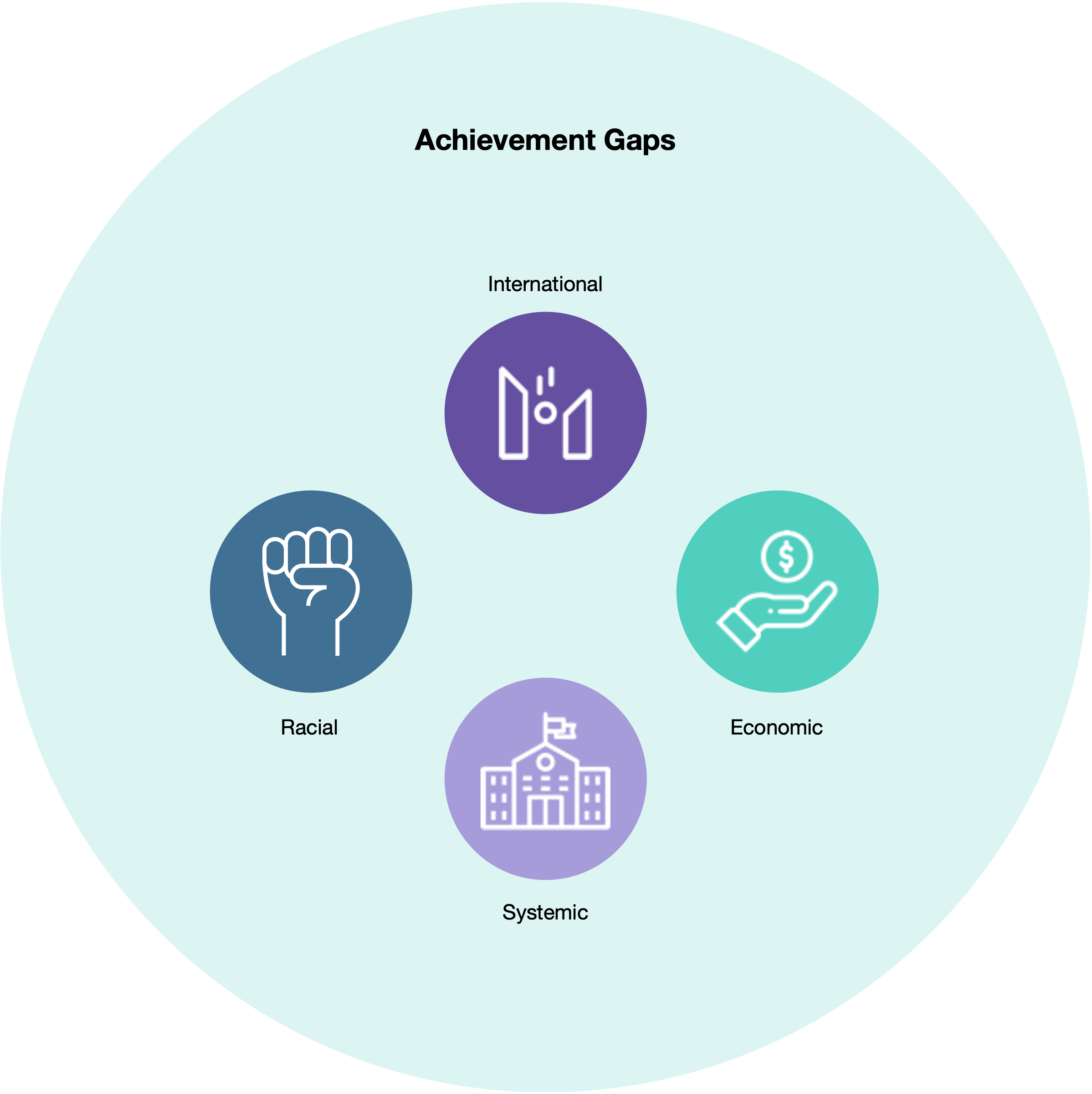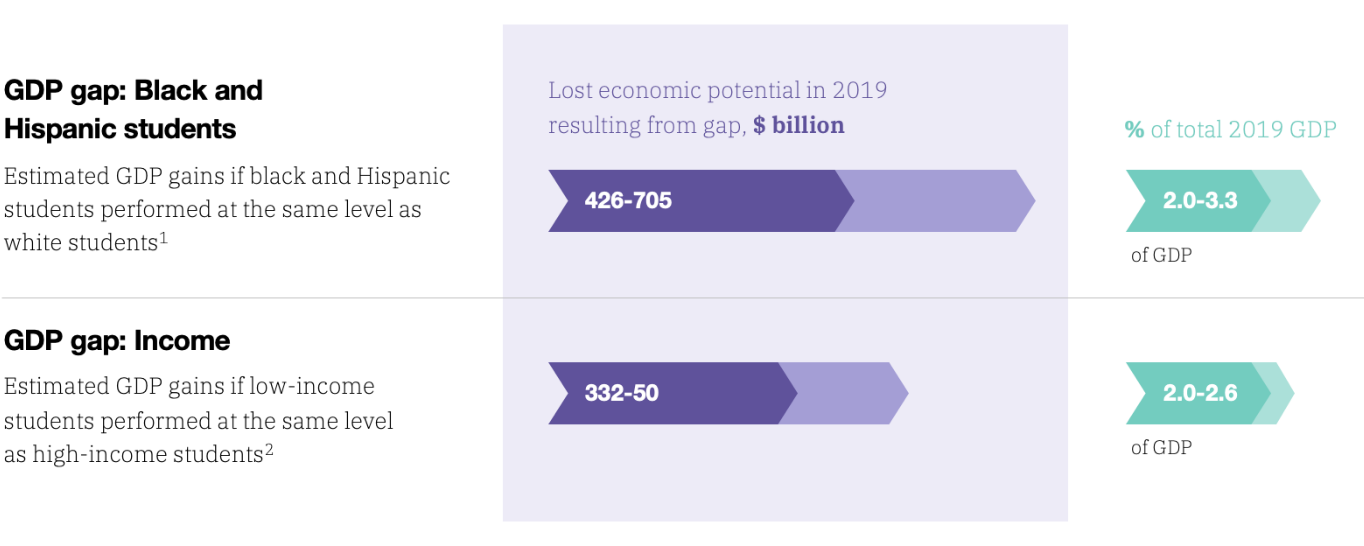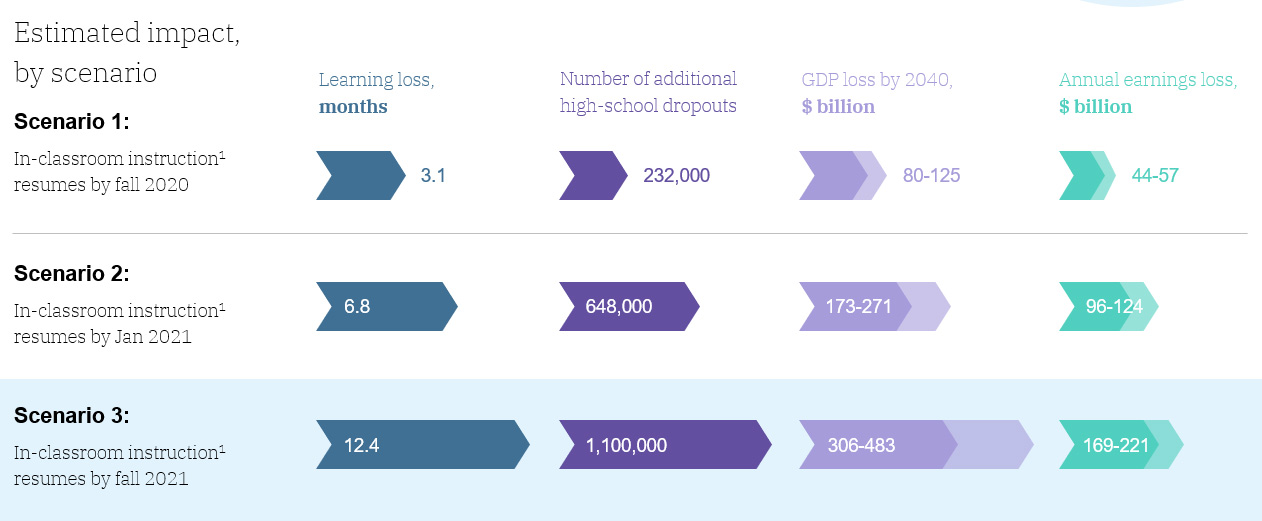Problem

Problem
Managing Me is designed to help students overcome longstanding achievement gaps and recent COVID-19 learning gaps.
ACHIEVEMENT GAPS
Achievement gaps are differences in educational success that exist between students of different groups. Educators measure these gaps using a variety of data points, such as standardized test scores, graduation rates, and attendance rates.
The achievement gaps reveal challenging truths about student achievement in the United States: Students in the United States perform behind their international Organization for Economic Co-operation and Development (OECD) peers. In addition, within the United States, white students generally perform better than black and Latinx students; and rich students generally perform better than poor students (a group defined as those eligible for federally subsidized free lunches).
The achievement gaps also reveal that this is a systemic problem: Students in certain schools or school districts generally perform better than students from other schools or school districts – regardless of the students’ ethnic, racial or economic background.

These achievement gaps impose heavy and often tragic consequences: This underutilization of human potential is costly for individuals and the United States. For individuals, avoidable shortfalls in academic achievement impose heavy and often tragic consequences, via lower earnings, poorer health, and higher rates of incarceration. For the country, the United States is not developing a workforce with the skills necessary to compete and succeed in the global economy. This translates to achievement gaps costing the United States hundreds of billions of dollars – and the economic equivalent of a permanent national recession.
It is estimated that if the black and Hispanic student-achievement gap had been closed in 2009, the 2019 US GDP would have been $426 billion to $705 billion higher. If the income-achievement gap had been closed, it is estimated that the 2019 US GDP would have been $332 billion to $550 billion higher.

Prior to the pandemic, Professor Paul Peterson, Director of the Program on Education Policy and Governance at Harvard’s Kennedy School, stated “Unless we pull ourselves up to the level of Canadians and Germans, we are going to be foregoing about a half percent of GDP growth that we could otherwise enjoy, enough to pay 20 percent more to all of our workers over the course of the 21st century. So, this is not just a story about what’s happening in school. This is a story about what’s happening to the quality of our workforce.”
1 NAEP 8th-grade math score: comparison of average scores of black and Hispanic students with white students.
2 NAEP 8th-grade math score: comparison between low-income (eligible for free lunch) students and high-income students.
EFFORTS TO OVERCOME ACHIEVEMENT GAPS
Educators and administrators have been wrestling with the achievement gaps for decades.
These are some of the strategies they have attempted:
- Teacher Incentives
- Academic Standards
- Statewide Mandates
- School Accountability
- Test-Based Curriculum
- More Teacher Training
- Resetting School Culture
- Leadership Changes
- Technology Literacy
- Classroom Discipline
- School Boundary Changes
- Smaller Class Sizes
- Parent Training
- Learning Apps
- Supplemental Instruction
- Technology Access
- Longer School Year
- ESL Support
- Professional Development
- Culturally Relevant Topics
- Teacher Hiring Quotas
- Personalized Learning
- Formative Assessments
- Evidence-Based Instruction
- Classroom Rigor
Despite valiant and creative attempts to drive progress, there is little to show for the effort.
COVID-19 LEARNING GAPS
The U.S. education system was in crisis. Then the COVID-19 pandemic prompted a historic shutdown of US schools which exacerbated the existing achievement gaps by an estimated 15 to 20 percent – and created learning gaps. Learning gaps are the difference between what a student is expected to have learned by a certain grade level versus what they have actually learned up to that point. In addition to learning loss, COVID-19 closures are expected to increase high-school drop-out rates (currently 6.5 percent for Hispanic, 5.5 percent for black, and 3.9 percent for white students, respectively).

While the damage to individuals is consequential, the consequences could go even deeper: the United States as a whole could suffer measurable harm. With lower levels of learning and higher numbers of drop-outs, students affected by COVID-19 are likely to be less skilled and therefore less productive than students from generations that did not experience a similar gap in learning. Furthermore, if other countries mitigate the impact of lost learning and the United States does not, this will harm US competitiveness. By 2040, most of the current K–12 cohort will be in the workforce. Estimates show a GDP loss of $173 billion to $271 billion a year—a 0.8 to 1.3 percent hit.
After these estimates were released, in August 2021, the NWEA nonprofit education organization, formerly the Northwest Evaluation Association, released new research and data showing that the learning gaps are worse than anticipated.
1 Or instruction as effective as in-classroom instruction.
EFFORTS TO OVERCOME THE COVID-19 LEARNING GAPS
The United States’ educational system is expected to spend years addressing the learning gaps caused by the historic shutdown of schools during the COVID-19 pandemic. In acknowledgement of this sobering reality, educators across the United States are receiving approximately $129 billion allocated to aid schools under the stimulus legislation, signed in March. The money is intended to help schools reopen during the pandemic, and according to the act, approximately 20 percent must be spent on helping students recover academically from the effects of school closures and remote learning – the learning gaps.
This has led to a historic opportunity for change.
Approximately
$129 billion goes directly
to K-12 education.
Approximately $110 billion goes directly to school districts. States and districts that serve low-income students will get more money per student. About $22 billion of this money must go to address lost learning.
Summer enrichment programs and after-school programs both will get at least $1.2 billion.
Programs and grants for students with disabilities will get about $2.6 billion.
The COVID-19 learning gaps and stimulus funding have educators
searching for programs with the potential to help close the gaps.
